TECHNICAL SCIENCES PAPER 1 GRADE 12 QUESTIONS - NSC EXAMS PAST PAPERS AND MEMOS JUNE 2019
Share via Whatsapp Join our WhatsApp Group Join our Telegram GroupTECHNICAL SCIENCES
PAPER 1
GRADE 12
NSC EXAMS
PAST PAPERS AND MEMOS JUNE 2019
INSTRUCTIONS AND INFORMATION
Read the following instructions carefully before answering the questions.
- Write your full NAME and SURNAME in the appropriate spaces on the ANSWER BOOK.
- The question paper consists of EIGHT questions.
- Start each question on a NEW page in the ANSWER BOOK.
- You may use a non-programmable calculator.
- You may use appropriate mathematical instruments.
- Number the answers correctly according to the numbering system used in this question paper.
- Show ALL formulae and substitutions in ALL calculations.
- Round off your FINAL numerical answers to a minimum of TWO decimal places.
- Give brief motivations, discussions, et cetera where required.
- A data sheet is attached for your use.
- Write neatly and legibly.
QUESTIONS
QUESTION 1: MULTIPLE-CHOICE QUESTIONS
Various options are provided as possible answers to the following questions. Choose the answer and write the letter (A−D) next to the question number (1.1−1.10) in the ANSWER BOOK, for example 1.11 D.
1.1 Which ONE of the following is a measure of the inertia of a body?
- Force
- Mass
- Density
- Acceleration (2)
1.2 The velocity of a car moving eastwards increases from 5 m.s-1to 10 m.s-1. 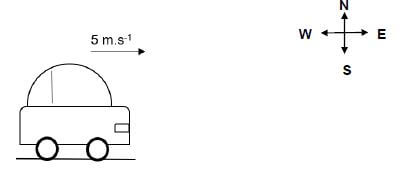
Which ONE of the following statements CORRECTLY describes the direction of the acceleration and the resultant (net) force while the car is accelerating? (2)
Direction of acceleration | Direction of resultant force | |
A | Due east | Due west |
B | Due west | Due east |
C | Due east | Due east |
D | Due west | Due west |
1.3 An object moves with constant velocity along a rough surface when a horizontal force of 5 N acts on it. 
The magnitude of the kinetic frictional force is …
- equal to zero.
- equal to 5 N.
- greater than 5 N.
- less than or equal to 5 N. (2)
1.4 Which ONE of the following is equal to the rate of change of momentum?
- Impulse
- Velocity
- Net force
- Acceleration (2)
1.5 A bricklayer wants to displace an object through a horizontal distance of 5 m. He applies a force of 10 N, but the object remains at rest. Work done by the brick layer on the object (in Joule) is …
- 0.
- 5.
- 10.
- 50. (2)
1.6 A girl pulls a box horizontally across a rough floor. The box moves in an easterly direction. The diagram below shows the force diagram of all the forces that act on the box.
Which ONE of the following forces does NEGATIVE work on the box?
- F1
- F2
- F3
- F4 (2)
1.7 A ball, moving horizontally east, hits a wall with a speed v m.s-1. The ball then bounces back horizontally with the same speed v m.s-1 as shown in the diagram below. 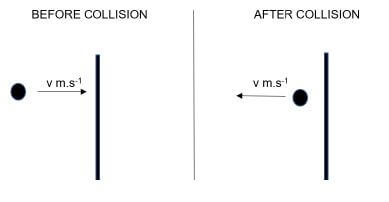
Which ONE of the following statements is TRUE about momentum p and kinetic energy Ek of the ball during the collision?
- Only p is conserved
- Only Ek is conserved
- Both p and Ek are conserved
- Both p and Ek are not conserved (2)
1.8 Which ONE of the following is defined as the normal force exerted by a liquid at rest on a given surface in contact with the liquid?
- Thrust
- Weight
- Stress
- Pressure (2)
1.9 Strain is defined as the …
- force acting per unit area.
- internal restoring force per unit area.
- force that changes the shape of an object.
- ratio of change in dimension to the original dimension. (2)
1.10 A material that has electrical conductivity between that of a conductor and an insulator is called a …
- metal.
- plastic.
- semiconductor.
- transition metal. (2) [20]
QUESTION 2 (Start on a NEW page.)
2.1 A girl is pulling a concrete block of mass 20 kg across a rough horizontal surface with a horizontal force of 50 N due east as shown in the diagram. The coefficient of kinetic friction is 0,2. 
2.1.1 Draw a free-body diagram showing ALL forces acting on the block. (4)
2.1.2 Calculate the kinetic frictional force experienced by the block. (4)
2.1.3 Determine the magnitude and direction of the net force acting on the block. (4)
2.1.4 State Newton’s Second Law of motion in words. (2)
2.1.5 Calculate the magnitude of the acceleration of the block. (3)
2.2 How does the acceleration in QUESTION 2.1.5 change if: (Write only INCREASES, DECREASES or REMAINS THE SAME)
2.2.1 Another block of mass 5 kg is attached to the 20 kg block by using a light string (1)
2.2.2 The 50 N force is acting at an angle of 20° with the horizontal (1)
2.2.3 The 20 kg block is placed on a smooth surface (1) [20]
QUESTION 3 (Start on a NEW page.)
3.1 A man pushes a car with a force of 100 N due east as shown in the figure. The car moves as the force is applied. 
3.1.1 State Newton’s Third Law in words. (2)
3.1.2 What is the magnitude and direction of the force exerted by the car on the man? (2)
3.2 A box is placed on top of a car which was initially at rest. The car suddenly starts to move due east. 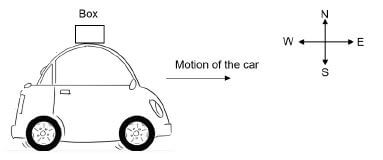
3.2.1 Describe what happens to the box when the car suddenly moves due east. (2)
3.2.2 Explain the answer to QUESTION 3.2.1 by referring to the relevant law in physics. (3) [9]
QUESTION 4 (Start on a NEW page.)
4.1 A design engineer in charge of the crashworthiness of new vehicle models conducts experiments by smashing them into fixed massive barriers at 14 m.s-1. A new model of a car of mass 1 500 kg takes 0,15 s from the time of impact until it is brought to rest.
4.1.1 Define the term impulse. (2)
4.1.2 Is impulse a vector or a scalar quantity? (1)
4.1.3 Calculate the impulse of the car. (4)
4.1.4 Calculate the magnitude of the force exerted by the barrier on the car. (3)
4.1.5 New cars have a crumple zone to help minimise injuries during accidents. Use principles in physics to explain how crumple zones help to minimise injuries during a collision. (3)
4.2 Car A of mass 800 kg is stationary at a traffic light. Another car, B, of mass 1 000 kg travelling at a speed of 33 m.s-1 collides with car A from behind as shown in the diagram below. Immediately after the collision car A moves to the right at 17 m.s-1. The kinetic energy is not conserved during the collision. 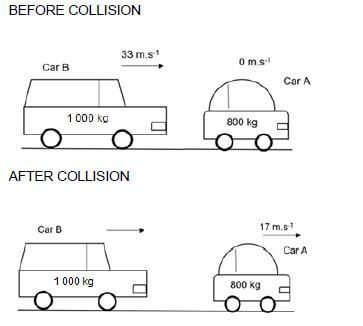
4.2.1 Define the term momentum. (2) 4.2.2 Differentiate between an elastic and inelastic collision. (4)
4.2.3 State the principle of conservation of linear momentum in words. (2)
4.2.4 Calculate the speed of car B after the collision. (4)
4.2.5 Is this collision elastic or inelastic? (1) [26]
QUESTION 5 (Start on a NEW page.)
5.1 A construction worker is pulling a box of mass 100 kg across a rough horizontal surface. The worker exerts a force 200 N at an angle 20° with the horizontal. The box moves at a constant velocity of 3 m.s-1to the left. The box is pulled over a distance of 5 m. 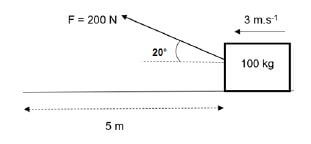
5.1.1 Define the term work done in words. (2)
5.1.2 Calculate the work done by the worker. (3)
5.1.3 What is the net work done on the box? (1)
5.1.4 Explain the answer in QUESTION 5.1.3 above. (2)
5.1.5 Does the force of gravity do any work on the box? Explain. (3)
5.2 An electric motor lifts 2 000 kg of water per minute to the top of a building which is 20 m high.
5.2.1 Define the term power. (2)
5.2.2 Calculate the power generated by the motor in horsepower. (4)
5.3 A block of mass m is dropped from rest from a height h metres above the ground as shown in the following diagram.
The block reaches point B, which is 1,5 m above the ground at a speed of 8 m.s-1. 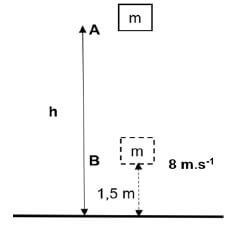
5.3.1 Define mechanical energy in words. (2)
5.3.2 Define gravitational potential energy in words. (2)
5.3.3 What change takes place on the following quantities while the block is falling? Write down only INCREASES, DECREASES or REMAINS THE SAME.
- Kinetic energy (1)
- Mechanical energy (1)
5.3.4 State the principle of conservation of mechanical energy in words. (2)
5.3.5 Calculate the height h from which the block was dropped. (7) [32]
QUESTION 6 (Start on a NEW page.)
6.1 Distinguish between a perfectly elastic body and a perfectly plastic body. (4)
6.2 State Hooke’s law in words. (2)
6.3 A string of length 2 m has an area of 5 x 10-5 m2.The string is pulled by a force of 200 N. The modulus of elasticity of the string is 4 x 108 N.m-2.
6.3.1 Define stress in words. (2)
Calculate the:
6.3.2 Stress on the string (3)
6.3.3 Final length of the string (6) [17]
QUESTION 7 (Start on a NEW page.)
7.1 Define viscosity. (2)
7.2 Modern engine oils are specially designed as multi-grades. Motor oils that are marked 10W40 and 5W40 are shown in the diagram below. 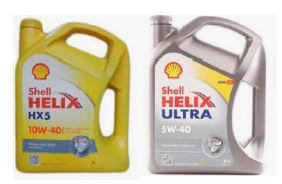
7.2.1 What does “W” in 10W40 represent? (2)
Which ONE of the two types of motor oils (10W40 or 5W40):
7.2.2 Has a higher viscosity at engine start up? (2)
7.2.3 Is recommended for the winter season? (2)
7.3 A hydraulic system is used to lift patients in a dentistry chair. A force of 100 N is applied on Piston A, with an area of 1,2 x 10-3 m2, to lift a patient of weight 1 200 N. 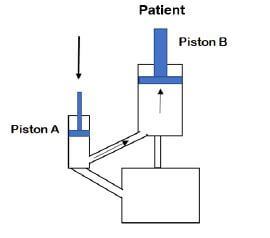
7.3.1 State Pascal’s law in words. (2)
7.3.2 Calculate the area of the Piston B. (3)
A doctor wants to lift a heavier patient but with a smaller applied force.
7.3.3 What design change must the doctor make to the system to achieve this? (2)
7.3.4 Give THREE applications of Pascal’s law. (3) [18]
QUESTION 8 (Start on a NEW page.)
An intrinsic semiconductor silicon, Si, is doped with an impurity element to produce an n-type semiconductor.
8.1 What is an intrinsic semiconductor? (2)
8.2 Define the term doping. (2)
8.3 Give the name of the impurity element that was added to produce an n-type semiconductor. (2)
8.4 What type of charge causes conduction in an n-type semiconductor? (2) [8]
TOTAL: 150
DATA FOR TECHNICAL SCIENCES GRADE 12
PAPER 1
TABLE 1: PHYSICAL CONSTANTS
NAME | SYMBOL | VALUE |
Acceleration due to gravity | g | 9,8 m·s-2 |
Permittivity of free space | ε0 | 8,85 × 10-2 F.m-1 |
TABLE 2: FORMULAE
FORCE
Fnet = ma | p= mv |
fsmax = µsN | fk = µkN |
FnetΔt = Δp | Fg =mg |
WORK, ENERGY AND POWER
W =FΔxcosθ | U= mgh or EP = mgh |
K = ½mv2 or Ek = ½mv2 | Wnet = ΔK or Wnet = ΔEk ΔK = Kf −Ki or ΔEk =Ekf − Eki |
Wnc= ΔK + ΔU or Wnc= ΔEk + ΔEp | P = W Δt |
Pav = Fv | ME = Ek+ Ep |
ELASTICITY, VISCOCITY AND HYDRAULICS
| σ = F A | ε = Δl / Strain = Change in length L Original length |
| σ = K / Stress = Modulus of elasticity ε Strain | F1 = F2 A1 A2 |
| P = pgh | Pressure (P) = Force(F) Area |